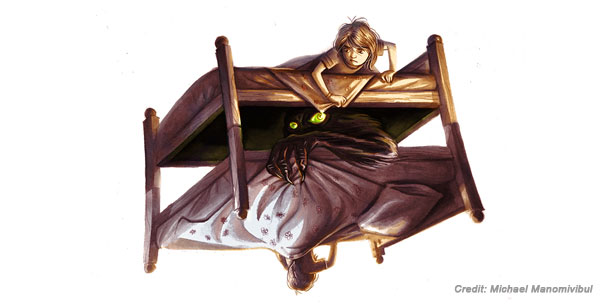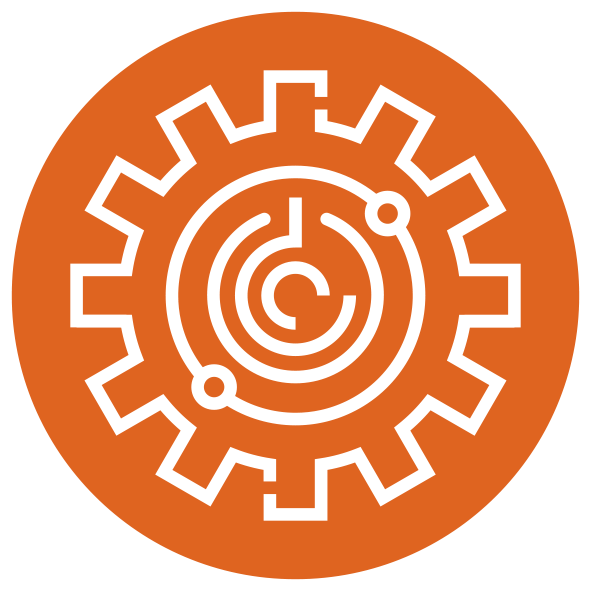Submitted by Liam Hogan
on November 02, 2015

QUANTUM SHORTS 2015: FIRST PRIZE, OPEN CATEGORY
>>Read an interview with the author
It’s weird, the things that can mess up a kid’s head. Take Ana, for example. She was convinced that every time she looked under her bed, the Universe split in two. In a parallel world in which a mirror Ana also looked under her bed before going to sleep and after saying her prayers and where, up until then, she’d never found anything bad, this time there would be a ghastly demon with wicked teeth and blood-stained claws, whose only desire was to catch and tear apart Ana, aged six and three quarter years.
Little wonder she said her prayers before she looked. Little wonder she had nightmares.
I told her that wasn’t the way the multiverse theory worked. That for every Ana that found a slavering beast, there was one that found a toy she’d lost, or one that forgot to look under the bed.
She skewered me with her most outraged look. This Ana never forgot.
But it’s hard arguing theoretical physics with a child yet to turn seven and, as I wasn’t prepared to deny the theory outright, it was clear this notion was not going to be an easy one to shift. It wasn’t simply that she had a binary, yes versus no, either-or view of the coin toss that happened in her imagination every time she lifted the skirt that kept under-the-bed out-of-sight. It was because what terrified her, wasn’t the finding a monster under her bed, it was the not finding a monster under her bed. In her head, every time she survived, she doomed the parallel Universe Ana to a grisly death. It was the guilt that was crushing her.
“Why don’t you not look?” I reasoned.
“I have to,” she replied with an air of ancient sorrow. “There might be a monster under the bed. I have to check. And even if I don’t, the other Ana will.”
This had me scratching my head, figuratively speaking. I’m a psychologist by trade, not a physicist. Wouldn’t that require the Universe to have already split? And, once the other Ana looked, it would be her Universe that split again, not this Ana’s. Maybe this was something I could use.
I thought of her parents. Reading between the lines, not a tricky task with those two, they wanted me to crush Ana’s creativity. To make her as easy to handle as she had been twelve months earlier. To make her ‘normal’. But normal wasn’t an option; it was clear this precocious child had the potential to far exceed the pretensions of her middle class parents.
“Ana,” I said, “Who looks first? You, or the other Ana?”
She suspected a trick and trod carefully. “We both…” then she corrected herself. “There is no other Ana, not until I look. Or there is, but it’s me and we haven’t split yet.”
“If she is you, will she react to finding the monster the same way you would?”
She sucked air through the gap in her front teeth. “I guess.”
“And how would you react, if, when you looked under the bed, you found a monster there? What would you do?”
“I…”
I waited. The silence stretched between us. This was somewhere she hadn’t been before. “I don’t know,” she said quietly.
“But you’d do something? You wouldn’t just sit there?”
“No,” she agreed. “I’d run… hide. Scream, maybe.”
“I’m sure you would. And what would your parents do, if they heard you scream?”
“They’d come running,” she said, and they would. Any parent would.
I let her think about this for a moment. “Ana, you’re intelligent, resourceful, and brave. And the other Ana, she is exactly the same. She is, after all, you. She – you – would not take it lying down. You’d fight, you’d run. Your parents would help. The one thing you would never be, is a victim. Don’t think I haven’t noticed the hobby horse propped up against the toy chest, ready for action.”
“And the roller skates on the landing,” she said.
I wasn’t sure how the roller skates would help. Perhaps she hoped the monster would trip on them. She’d be upset if I told her that her mother wordlessly tidied them up each night. “And the skates,” I diplomatically agreed. “It’s not much, perhaps, but you’re doing the best you can. And so would the other Ana. No monster is going to get a free lunch in this house.”
She laughed, a lovely little laugh, made all the more charming by its rarity of use.
I pushed on. “So it’s not a foregone conclusion that the monster always wins. And if it does not-”
“-Then there are two Anas!” she interrupted.
This wasn’t quite where I’d been going. I wanted her to acknowledge that she wasn’t responsible for what happened in the other Universes. How could she be? But sometimes, usually in fact, you had to let your patient find their own path.
“And then four, and then eight, and then…” she babbled on.
A small chime rang out on my wristwatch. “Okay Ana. I think we’ve made good progress. We’ll leave it there for today.”
A muffled voice came through the door. “Ana? Honey? Who are you talking to in there?”
Ana called back, “No one, mummy.”
Which was an illuminating denial. I jotted it down for future discussion, curious to see if Ana’s mother would come into the bedroom. “Okay sweetie,” she caved in, as I suspected she would. “But go to sleep now, you hear?”
Ana waited until the footsteps faded away down the hall. “Goodnight, Doctor.”
“Goodnight, Ana,” I replied, “sleep tight.”
And then I slid myself back under her bed, listening to her breathing softly slow and waiting for tomorrow night, when she would once again lift the covers, and – all being well – discover me lying there, ready for our next session.
About the Author
Liam is a London based writer and host of the award winning monthly literary event, Liars’ League. He was a finalist in Sci-Fest LA’s Roswell Award 2015, and has had work published in Leap Books’ “Beware the Little White Rabbit” #Alice150 anthology, and in Sci-Phi Journal.



